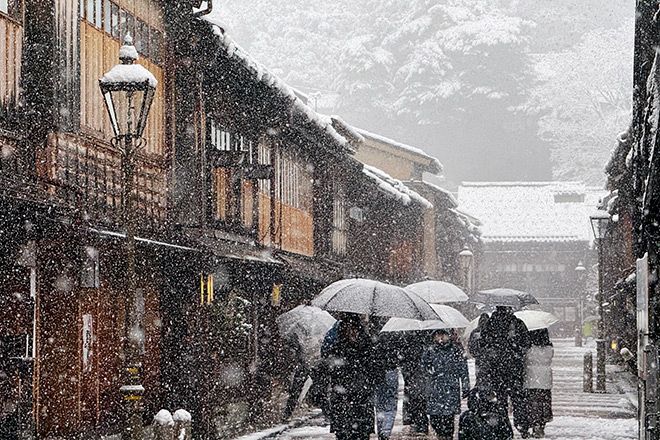Snow falls in Kanazawa, the capital of Ishikawa Prefecture, and in Obihiro city in Hokkaido (Tatsuo Kanai and Shigehito Nakazawa)
Snowfall reached record levels in eastern Hokkaido while blanketing other parts of the Japanese archipelago on Feb. 4, and more snow is forecast for wide areas through Feb. 6.
The heavy snow is being caused by the intermittent flow of “the strongest cold air mass of this winter.”
Obihiro city in Hokkaido recorded 124 centimeters of snow in the 24-hour period ending at 9 a.m. on Feb. 4, the highest figure since such statistics became available in 1999.
In the 24-hour period ending at 6 a.m. on Feb. 5, the Yasuzuka district of Joetsu, Niigata Prefecture, received 85 cm of snow while 78 cm landed in Shirakawa village in Gifu Prefecture.
The strong winter pressure pattern is expected to continue for several days, and the accumulation of snow is expected to increase, especially on the Sea of Japan side.
Heavy snow will fall mainly inland on the Pacific Ocean side of the Tokai, Shikoku and southern Kyushu regions, where snowfalls are fairly rare.
In some areas of these regions, the snow will likely accumulate, even on the plains.
The effects of the snow are expected to linger over a wide area until around Feb. 8.
The Japan Meteorological Agency has cautioned the public about icy roads, snow on power lines, snowstorms and high waves.
For the 24-hour period ending at 6 a.m. on Feb. 6, the JMA has forecast 100 cm of snow in the Tohoku and Hokuriku regions, 70 cm in the Tokai and Kinki regions, and 50 cm in Hokkaido and the Chugoku and northern Kyushu regions.
In the 24-hour period ending at 6 a.m. on Feb. 7, snowfall amounts are expected to be 70 cm in the Tohoku and Hokuriku regions, and 50 cm in Hokkaido and the Tokai and Kinki regions.
SNOW REMOVAL EXPENSES SOAR
Municipalities hit by heavy snowfalls are struggling to cover the expenses for snow removal, which have also hit record high levels in some areas.
Many snow-hit municipalities this winter have compiled supplementary budgets because of insufficient funds for snow removal.
Hakuba village in Nagano Prefecture, one of the most popular winter destinations in Japan, has been struggling with snow this season.
“This year, we have had more snow than usual, and it has been very difficult to remove the snow,” said a village government official in charge of snow removal.
In Hakuba, the total amount of snowfall in December 2024 was 214 cm, 84 cm higher than average and 152 cm more than in December 2023.
The village government had allocated 210 million yen ($1.37 million) for snow removal in the initial budget for fiscal 2024. However, the village had to add 120 million yen in a supplementary budget for that purpose in January.
Snowplows operated for 4,478 hours in Hakuba during the month from late November, about 4.5 times the total for the same period in 2023.
“The shortage of operators of snow removal trucks and the rising cost of fuel are also contributing to the high cost,” the official said.
Aomori Prefecture, located on the northern tip of the Honshu main island, is facing similar problems.
Heavy snowfall has hit the prefecture since the end of 2024, including 126 cm in Hirosaki city, the deepest level recorded for a January.
Aomori city was covered in 139 cm of snow, well above normal.
In January, the Aomori prefectural government approved a supplementary budget of 2.265 billion yen for snow removal and clearance on prefectural roads.
Snow removal expenses for the current fiscal year totaled 8.42 billion yen, the largest ever for the prefecture.
The Aomori prefectural capital’s 6.2 billion yen and Hirosaki’s 2.3 billion yen in snow-removal costs were also records for the cities.
Aomori Governor Soichiro Miyashita told a news conference on Feb. 4 that he has instructed officials to “be more thorough than ever in clearing snow from prefectural and national roads.”
“I consider snow removal to be a basic winter service for residents,” he said.
EMERGENCY FUNDS
The central government has also been worried that heavy snowfall could hinder the financial management of local governments.
The internal affairs ministry moved up the schedule for a special subsidy tax and granted about 16.6 billion yen to 124 municipalities in 11 prefectures on Jan. 22.
The special tax is normally granted in December and March of each fiscal year in response to urgent local circumstances, such as medical care, transportation and disaster relief.
According to the infrastructure ministry, 16.4 billion yen was additionally allocated to 316 local governments, including prefectures, for snow removal on roads in fiscal 2023.
“We will consider the allocation (for fiscal 2024) by the end of the fiscal year after hearing about snow conditions and other factors,” a ministry official said. “We will support the speedy removal of snow from roads.”
(This article was compiled from reports written by Shoko Rikimaru, Ryo Suganuma, Yusuke Noda and Ryoji Koko.)


AloJapan.com